If you’re here, chances are you’re dealing with the frustrating, sometimes overwhelming pain that comes with sciatica. The numbness, the sharp jolts, the ache that travels from your lower back down your leg can feel isolating and exhausting.
Experts on Pyng understand how deeply this pain can affect not only your body but your peace of mind. Let’s explore yoga practices for the sciatica nerve pain and you can also connect with experts for further support.
What is Sciatica?
Sciatica is a nerve condition that occurs when the sciatic nerve, running from your lower back down each leg, is compressed or irritated. Common causes include herniated discs, spinal stenosis, or tight muscles like the piriformis. Symptoms range from sharp, shooting pain to numbness and tingling, usually on one side of the body. Yoga for Sciatica nerve pain focuses on relieving this pressure and improving circulation around the nerve.
How Can Yoga Help Relieve Sciatica Nerve Pain?
Yoga for Sciatica is known to:
Stretch and strengthen muscles around the lower back
Improve posture and spinal alignment
Calm the central nervous system
Reduce stress and anxiety, which often worsen nerve pain
Enhance circulation to the affected area
Incorporating yoga for the nervous system can help balance the sympathetic and parasympathetic responses, allowing the body to heal more effectively.
Best Yoga Poses for Sciatica Relief
Practising the right yoga poses for sciatica consistently can reduce pain and prevent future flare-ups. Below are some of the most effective poses, along with how they help and how to do them safely.
1. Child’s Pose (Balasana)
How it helps: Gently stretches the lower back, hips, and thighs while calming the nervous system, making it ideal for relieving tension caused by sciatica.
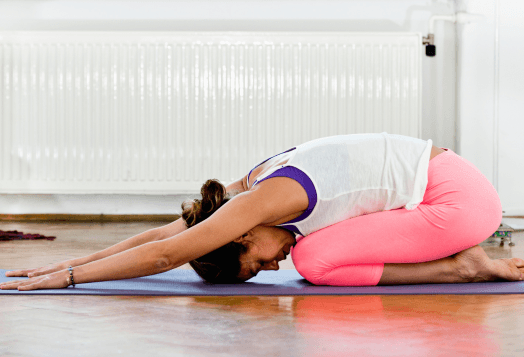
How to do it: Kneel on the floor, sit back on your heels, and stretch your arms forward while lowering your torso. Rest your forehead on the mat and breathe deeply for 1-2 minutes.
2. Downward-Facing Dog (Adho Mukha Svanasana)
How it helps: Stretches the hamstrings, calves, and spine. Promotes spinal decompression and improves circulation, reducing sciatic nerve irritation.
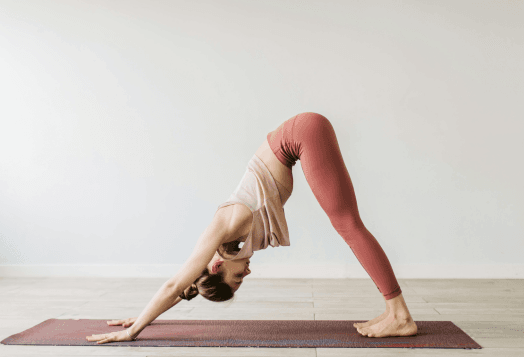
How to do it: Start on all fours, tuck your toes, and lift your hips to form an inverted V. Press your heels toward the floor and keep your head between your arms.
3. Cobra Pose (Bhujangasana)
How it helps: Strengthens the lower back, opens up the chest, and activates the parasympathetic nervous system, which can help ease nerve-related stress.

How to do it: Lie face down, hands under shoulders. Inhale, press into your palms, and gently lift your chest while keeping your elbows slightly bent.
4. Cat-Cow Pose
How it helps: Encourages spinal mobility and fluid movement, helping release tension along the spine and soothe irritated nerves.
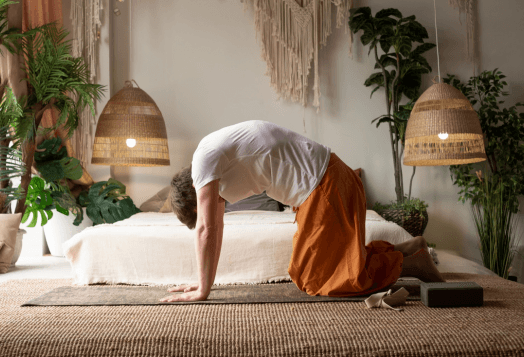
How to do it: Start on hands and knees. Inhale to arch your back (cow), lifting your head and tailbone. Exhale to gently round your spine (cat), tucking your chin and pelvis.
5. Supine Pigeon Pose (Figure Four Stretch)
How it helps: Opens the hips and stretches the piriformis muscle, which is often responsible for sciatic nerve compression.

How to do it: Lie on your back, cross one ankle over the opposite thigh. Gently pull the uncrossed leg toward your chest and hold for 30-60 seconds.
6. Bridge Pose (Setu Bandhasana)
How it helps: Strengthens the glutes, hamstrings, and lower back while providing a gentle backbend to open up the hip flexors.
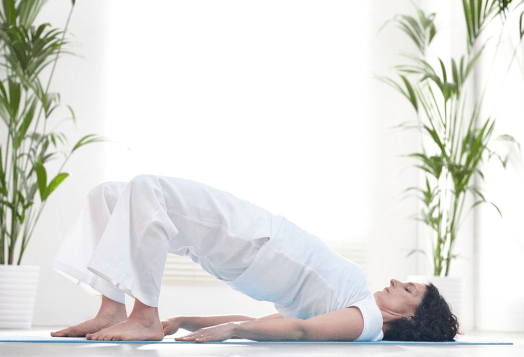
How to do it: Lie on your back with knees bent and feet flat. Press into your feet and lift your hips, clasping hands under your back for support.
7. Seated Forward Bend (Paschimottanasana)
How it helps: Stretches the spine, hamstrings, and lower back, promoting relaxation and soothing the nervous system.
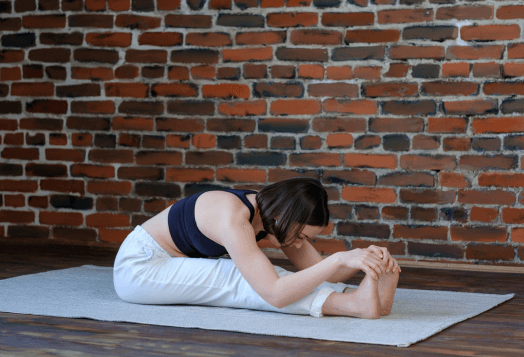
How to do it: Sit with legs extended. Inhale to lengthen the spine, exhale to fold forward from the hips, reaching toward your feet. Avoid rounding your back.
Yoga Poses to Avoid for Sciatica
While yoga offers numerous benefits for managing sciatica nerve pain, certain poses may actually aggravate symptoms if not practised mindfully. Knowing what to avoid is just as important as knowing what to practice.
Forward bends with rounded backs, for instance, may seem harmless, but they can put excessive pressure on herniated discs or a tight lower back. When the spine is flexed without support, it can exacerbate nerve compression, leading to increased pain or tingling.
Deep twisting poses, especially those that involve spinal rotation under pressure (like seated spinal twists), can increase irritation along the sciatic nerve path. These poses may feel relieving initially, but can be harmful if you’re already dealing with nerve inflammation.
Intense backbends, such as Full Wheel or Camel Pose, may overstretch the lower spine and compress vertebrae if your core isn’t properly engaged or if you're lacking lumbar support.
If you love these poses or they're part of your regular practice, don’t worry, you don’t have to abandon them altogether. Modifying them with props like bolsters, folded blankets, or blocks can reduce strain and make the poses accessible and safe. Better yet, work with a certified Pyng yoga trainer who can tailor a therapeutic sequence specifically for your condition and body needs.
Additional Tips for Practising Yoga Safely with Sciatica
Managing sciatica nerve pain with yoga can be incredibly effective, but only when practised with awareness. Here are some expert-backed tips to keep your routine both therapeutic and safe, especially when focusing on yoga for nerves:
Tip 1: Begin with a gentle warm-up.
Before diving into deeper poses, loosen up with gentle movements like pelvic tilts or gentle Cat-Cow stretches. A warm body is less prone to strain and helps activate the nervous system for healing.
Tip 2: Modify using yoga props.
Yoga blocks, bolsters, and straps aren’t just for beginners; they’re essential tools to maintain alignment and reduce pressure on the sciatic nerve. These modifications allow you to enjoy the best yoga poses for sciatica with safety and support.
Tip 3: Listen to your body and avoid aggravating pain.
If any movement triggers sharp, shooting, or tingling sensations down your leg, stop immediately. Unlike muscle soreness, nerve pain should never be pushed through.
Tip 4: Prioritise spine alignment and nervous system balance.
Don’t chase flexibility. Focus instead on movements that stabilise the spine and nourish the nervous system. Poses like the Bridge are great examples of yoga for lower back pain and nerve health.
Tip 5: Incorporate breathwork to calm your stress response.
Practising pranayama(like alternate nostril breathing) helps lower cortisol and shift your body into a parasympathetic state, which is important for those dealing with chronic nerve pain and tension.
Lifestyle and Holistic Tips for Nerve & Spine Health
Sciatica doesn’t begin and end on the mat. Your lifestyle choices play a massive role in managing symptoms and supporting long-term healing. By making small, consistent changes off the mat, you can reinforce the benefits of yoga poses for the sciatica nerve and improve overall nerve health. Here are some holistic wellness tips to complement your practice:
Tip 1: Embrace an anti-inflammatory diet.
Nerve pain and inflammation go hand-in-hand. Incorporating foods rich in omega-3 fatty acids (like flaxseeds and walnuts), leafy greens, berries, and turmeric can naturally reduce inflammation and support nerve regeneration.
Tip 2: Hydrate for disc and nerve function.
Staying hydrated helps cushion your vertebrae and supports better conductivity in your nervous system. Aim for 2-3 litres of water a day, especially if you’re incorporating yoga for lower back pain into your routine.
Tip 3: Practice daily mindfulness or Yoga Nidra.
Yoga Nidra and mindfulness meditation trigger the parasympathetic nervous system. These practices can reduce cortisol levels, improve sleep, and create a calming feedback loop for chronic nerve pain.
Tip 4: Maintain a healthy body weight.
Excess weight can compress the lumbar spine, worsening sciatica symptoms. Combining gentle yoga for sciatica pain relief with balanced nutrition can help shed stress from both your spine and nervous system.
A Gentle Path Forward
Healing from sciatica doesn't happen overnight, but with patience, compassion, and consistent support, it does happen. By focusing on yoga for sciatica pain, nurturing your nervous system, and building daily habits that support your spine, you’re choosing empowerment over pain. With Pyng, you’re never alone on this journey—connect with meditation coaches to guide your healing. Every gentle movement, every conscious breath, and every moment of stillness is a step closer to comfort, strength, and freedom.




